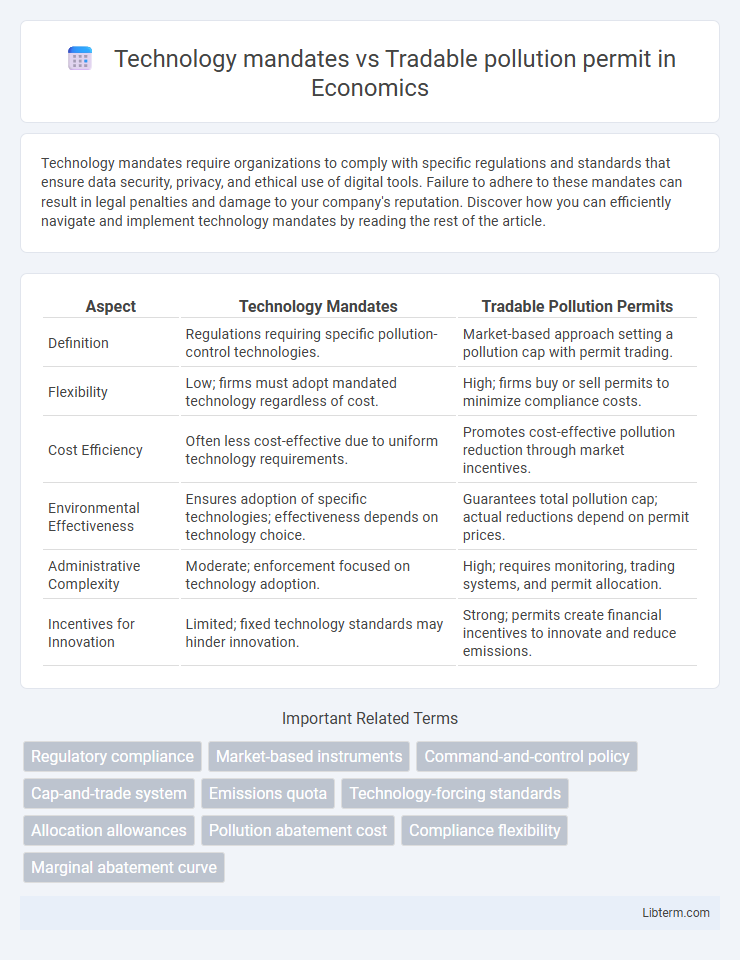Technology mandates require organizations to comply with specific regulations and standards that ensure data security, privacy, and ethical use of digital tools. Failure to adhere to these mandates can result in legal penalties and damage to your company's reputation. Discover how you can efficiently navigate and implement technology mandates by reading the rest of the article.
Table of Comparison
| Aspect | Technology Mandates | Tradable Pollution Permits |
|---|---|---|
| Definition | Regulations requiring specific pollution-control technologies. | Market-based approach setting a pollution cap with permit trading. |
| Flexibility | Low; firms must adopt mandated technology regardless of cost. | High; firms buy or sell permits to minimize compliance costs. |
| Cost Efficiency | Often less cost-effective due to uniform technology requirements. | Promotes cost-effective pollution reduction through market incentives. |
| Environmental Effectiveness | Ensures adoption of specific technologies; effectiveness depends on technology choice. | Guarantees total pollution cap; actual reductions depend on permit prices. |
| Administrative Complexity | Moderate; enforcement focused on technology adoption. | High; requires monitoring, trading systems, and permit allocation. |
| Incentives for Innovation | Limited; fixed technology standards may hinder innovation. | Strong; permits create financial incentives to innovate and reduce emissions. |
Introduction to Pollution Control Strategies
Technology mandates require firms to implement specific pollution control technologies, ensuring uniform emission reductions across industries regardless of individual abatement costs. Tradable pollution permits create a market for emission allowances, providing economic incentives for firms to reduce pollution cost-effectively by buying and selling permits based on their marginal abatement costs. Both strategies aim to control pollution levels but differ in flexibility, cost-effectiveness, and enforcement mechanisms within environmental regulation frameworks.
Defining Technology Mandates
Technology mandates require firms to adopt specific pollution control technologies regardless of cost, ensuring uniform environmental standards. These mandates differ from tradable pollution permits, which allow companies to buy and sell emission rights to meet regulatory limits flexibly. Defining technology mandates involves specifying the exact equipment or processes businesses must implement to reduce emissions.
Understanding Tradable Pollution Permits
Tradable pollution permits, also known as cap-and-trade systems, set a regulatory limit on total emissions and allocate or auction permits that firms can buy and sell, incentivizing cost-effective pollution reduction. Unlike technology mandates that dictate specific pollution control methods, tradable permits allow firms flexibility to innovate while meeting environmental goals, ensuring overall emissions stay within set caps. This market-based approach has been effective in reducing sulfur dioxide and carbon emissions by harnessing economic incentives for both compliance and innovation.
Key Differences Between Mandates and Permits
Technology mandates require firms to adopt specific pollution-control technologies, directly regulating the method of emission reduction, whereas tradable pollution permits set a cap on total emissions and allow firms to buy or sell allowances, providing flexibility in how reductions are achieved. Mandates guarantee uniform technology use but can be cost-inefficient, while permits incentivize firms to minimize costs by trading permits and adopting various abatement strategies. The key difference lies in the regulatory approach: mandates prescribe the means, and permits regulate the overall pollution outcome through market mechanisms.
Environmental Effectiveness Comparison
Technology mandates set specific pollution control standards that ensure consistent emission reductions by requiring firms to adopt designated technologies, which can guarantee compliance but may lack cost-efficiency. Tradable pollution permits create a market-driven approach allowing firms to buy and sell emission allowances, promoting overall pollution reduction at lower economic costs while providing flexibility in achieving environmental targets. Studies show tradable permits often achieve higher environmental effectiveness by incentivizing innovation and enabling emission reductions where they are most economical, whereas technology mandates may lead to uniform but potentially suboptimal outcomes.
Economic Efficiency and Costs
Technology mandates require firms to adopt specific pollution-control technologies, often leading to uniform compliance costs regardless of individual abatement efficiency, which can result in higher overall economic costs compared to market-based approaches. Tradable pollution permits establish a cap on total emissions and create a market where firms buy and sell allowances, promoting cost-effective pollution reduction by incentivizing low-cost abatement and enabling firms with higher marginal costs to purchase permits. Economic efficiency is typically greater under tradable permits, as this flexibility minimizes total compliance costs while ensuring environmental targets are met.
Flexibility and Innovation Potential
Technology mandates impose specific standards that limit flexibility by requiring firms to adopt predetermined pollution-control technologies, often hindering innovation tailored to unique operational contexts. Tradable pollution permits create a market-driven approach, providing firms the flexibility to reduce emissions cost-effectively and incentivizing innovation through the ability to trade allowances. The permit system encourages continuous improvement by rewarding firms that develop cleaner, more efficient technologies, fostering dynamic environmental and technological advancement.
Real-World Examples and Case Studies
Technology mandates require firms to use specific pollution control technologies, as seen in the U.S. Clean Air Act's catalytic converter mandate which significantly reduced vehicle emissions. Tradable pollution permits, exemplified by the European Union Emissions Trading System (EU ETS), allow companies to buy and sell emission allowances, incentivizing cost-effective pollution reduction. Case studies from China's carbon trading pilots demonstrate tradable permits' flexibility in rapidly industrializing economies, contrasting with technology mandates' rigid but reliable pollution control.
Challenges and Criticisms
Technology mandates often face challenges such as inflexibility and high compliance costs, limiting innovation by prescribing specific technologies rather than outcomes. Tradable pollution permits, while promoting cost-effective emissions reductions, encounter criticism for potential market volatility, permit overallocation, and difficulties in monitoring and enforcement. Both approaches struggle with balancing environmental goals and economic impacts, complicating effective policy implementation.
Choosing the Right Policy Approach
Technology mandates require firms to adopt specific pollution control technologies, ensuring a uniform standard but potentially lacking flexibility and cost-effectiveness. Tradable pollution permits, or cap-and-trade systems, set a total emissions cap while allowing firms to buy and sell allowances, promoting economic efficiency through market incentives. Choosing the right policy hinges on balancing administrative simplicity, environmental effectiveness, and economic impacts tailored to sector-specific emissions and regulatory goals.
Technology mandates Infographic

 libterm.com
libterm.com